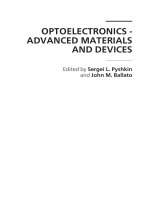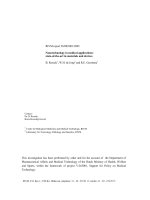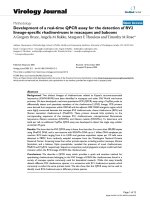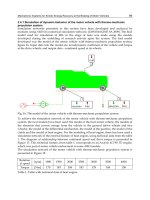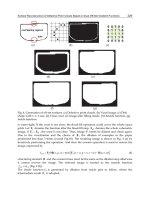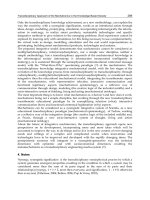METALLURGY – ADVANCES IN MATERIALS AND PROCESSES docx
Bạn đang xem bản rút gọn của tài liệu. Xem và tải ngay bản đầy đủ của tài liệu tại đây (26.64 MB, 186 trang )
METALLURGY –
ADVANCES IN
MATERIALS AND
PROCESSES
Edited by Yogiraj Pardhi
Metallurgy – Advances in Materials and Processes
Edited by Yogiraj Pardhi
Contributors
William A. Brantley, Satish B. Alapati, Hiroto Kitaguchi, Jakub Siegel, Ondřej Kvítek,
Zdeňka Kolská, Petr Slepička, Václav Švorčík, Ji Fan, Chuan Seng Tan, Mohammad Hosein Bina,
Ion Pencea, Dejan Tanikić, Vladimir Despotović
Published by InTech
Janeza Trdine 9, 51000 Rijeka, Croatia
Copyright © 2012 InTech
All chapters are Open Access distributed under the Creative Commons Attribution 3.0 license,
which allows users to download, copy and build upon published articles even for commercial
purposes, as long as the author and publisher are properly credited, which ensures maximum
dissemination and a wider impact of our publications. After this work has been published by
InTech, authors have the right to republish it, in whole or part, in any publication of which they
are the author, and to make other personal use of the work. Any republication, referencing or
personal use of the work must explicitly identify the original source.
Notice
Statements and opinions expressed in the chapters are these of the individual contributors and
not necessarily those of the editors or publisher. No responsibility is accepted for the accuracy
of information contained in the published chapters. The publisher assumes no responsibility for
any damage or injury to persons or property arising out of the use of any materials,
instructions, methods or ideas contained in the book.
Publishing Process Manager Marijan Polic
Typesetting InTech Prepress, Novi Sad
Cover InTech Design Team
First published September, 2012
Printed in Croatia
A free online edition of this book is available at www.intechopen.com
Additional hard copies can be obtained from
Metallurgy – Advances in Materials and Processes, Edited by Yogiraj Pardhi
p. cm.
ISBN 978-953-51-0736-1
Contents
Preface VII
Chapter 1 Heat Treatment of Dental Alloys: A Review 1
William A. Brantley and Satish B. Alapati
Chapter 2 Microstructure-Property Relationship
in Advanced Ni-Based Superalloys 19
Hiroto Kitaguchi
Chapter 3 Gold Nanostructures Prepared on Solid Surface 43
Jakub Siegel, Ondřej Kvítek, Zdeňka Kolská,
Petr Slepička and Václav Švorčík
Chapter 4 Low Temperature Wafer-Level Metal Thermo-Compression
Bonding Technology for 3D Integration 71
Ji Fan and Chuan Seng Tan
Chapter 5 Homogenization Heat Treatment to Reduce
the Failure of Heat Resistant Steel Castings 95
Mohammad Hosein Bina
Chapter 6 Multiconvolutional Approach to Treat the Main
Probability Distribution Functions Used to Estimate
the Measurement Uncertainties of Metallurgical Tests 117
Ion Pencea
Chapter 7 Artificial Intelligence Techniques for Modelling
of Temperature in the Metal Cutting Process 153
Dejan Tanikić and Vladimir Despotović
Preface
In recent decades scientists and engineers around the globe have been responding to
the requirement of high performance materials through innovative material research
and engineering. The ever increasing demand on quality and reliability has resulted in
some dazzling technological achievements in the area of advanced materials and
manufacturing. A number of new tools and techniques have been developed along
with extending current capabilities from performance perspective.
The purpose of this book is to bring together significant findings of leading experts, in
developing and improving the technology that supports advanced materials and
process development. The contributions made by researchers in these fields are
immensely valuable. From gold nano-structures to advanced superalloys, this book
covers investigations involving modern computer based approaches as well as
traditional experimental techniques. Some of the techniques described in this book
include, artificial intelligence based approaches to metal cutting, multi-conventional
mathematical model based technique to the measure uncertainties in metallurgical
tests and low temperature bonding technology for 3D integration. Selected articles
include research output on advances made in materials that are used not only in
complex structures such as aeroplanes but also in clinical treatments. There are
chapters that present research on Ni based superalloys, gold nanostructures, heat
resistance steels and advanced dental alloys. Individual texts include introduction to
the topics presented, illustrative procedures used in the investigations, results of study
undertaken and qualitative discussion, based on the findings, with a summary at the
end.
This book is formulated with chapters which describe the most recent work in
materials and process development at the time of publication. It is envisaged that it
will promote knowledge transfer across the materials society including university
students, engineers and scientists to built further understanding of the subject. It is
assumed that the reader has elementary knowledge of the materials and processes
described in this book. In cases where details are required, appropriate references will
assist the further understanding. It is hoped that, the reader will find the work
presented exciting, challenging and valuable as the original investigators intended.
VIII Preface
The editor would like to thank all contributing authors for their hard work and
patience throughout the publication process. Acknowledgement is also due to InTech
open science and the publication process manager for their excellent cooperation
during review and editing stages.
Dr. Yogiraj Pardhi
School of Metallurgy and Materials, University of Birmingham,
United Kingdom
Chapter 1
© 2012 Brantley and Alapati, licensee InTech. This is an open access chapter distributed under the terms of
the Creative Commons Attribution License ( which permits
unrestricted use, distribution, and reproduction in any medium, provided the original work is properly cited.
Heat Treatment of Dental Alloys: A Review
William A. Brantley and Satish B. Alapati
Additional information is available at the end of the chapter
1. Introduction
Metallic materials have widespread use in dentistry for clinical treatment and restoration of
teeth. Major areas of usage are: (1) restorative dentistry and prosthodontics (dental amalgam
and gold alloy restorations for single teeth, metallic restorations for multiple teeth, including
metal-ceramic restorations, removable partial denture frameworks, and dental implants), (2)
orthodontics (wires which provide the biomechanical force for tooth movement), and (3)
endodontics (rotary and hand instruments for treatment of root canals). Heat treatment of
the metal can be performed by the manufacturer, dental laboratory, or dentist to alter
properties intentionally and improve clinical performance. Heat treatment of the metal also
occurs during the normal sequence of preparing a metal-ceramic restoration, when dental
porcelain is bonded to the underlying alloy substrate. Moreover, intraoral heat treatment of
some metallic restorations occurs over long periods of time. There is an enormous scientific
literature on the heat treatment of metals for dentistry. A search of the biomedical literature
in May 2012, using PubMed [ revealed nearly 450
articles on heat treatment of dental alloys. The purpose of this chapter is to provide a review
of the heat treatment of metallic dental materials in the foregoing important areas,
describing the important property changes, with a focus on the underlying metallurgical
principles.
2. Restorative dentistry and prosthodontics
2.1. Dental amalgams
Dental amalgams are prepared in the dental office by mixing particles of a silver-tin-copper
alloy for dental amalgam that may contain other trace metals with liquid mercury. The
initially mixed (termed triturated) material is in a moldable condition and is placed (termed
condensed) directly by the dentist into the prepared tooth cavity, where it undergoes a
setting process that produces multiple phases and can require up to one day for near
Metallurgy – Advances in Materials and Processes
2
completion. Extensive information about the several different types of dental amalgams are
provided in textbooks on dental materials [1,2]. Particles of the alloy for dental amalgam are
manufactured by either lathe-cutting a cast ingot or directing the molten alloy through a
special nozzle. Both the machining of the lathe-cut particles and the rapid solidification of
the spherical particles create residual stress. In addition, the microstructure of the solidified
silver-tin-copper alloy has substantial microsegregation. Consequently, manufacturers of the
alloy powder for dental amalgam perform a proprietary heat treatment to relieve residual
stresses and obtain a more homogeneous microstructure. This heat treatment is of
considerable practical importance since it affects the setting time of the dental amalgam after
the powder is mixed with mercury. Subsequently, the dental amalgam restorations undergo
intraoral aging, which can be regarded as heat treatment, and detailed information about
the microstructural phase changes for prolonged intraoral time periods has been obtained
from clinically retrieved dental amalgam restorations [3].
2.2. Gold alloys for all-metal restorations
Gold alloys are principally used for all-metal restorations (inlays, crowns and onlays) in
single posterior teeth. These alloys are cast by a precision investment process, and the
restorations are cemented by the dentist into the prepared tooth cavity. The original gold
casting alloys contained over approximately 70 wt.% gold, but the very high price of gold
has led to the development of alloys that contain approximately 50 wt.% gold. These
alloys also contain silver, copper, platinum, palladium, zinc, and other trace elements,
including iridium for grain refinement. Information about the dental casting process and
the gold alloys is available in dental materials textbooks [1,2]. Detailed compositions and
mechanical properties of specific alloys are available on the website of the major
manufacturers. Another valuable reference is the current ISO Standard on metallic
materials for fixed and removable dental appliances [4], which stipulates mechanical
property requirements. In the normal dental laboratory procedure, gold castings for all-
metal restorations are water-quenched after solidification, following loss of the red heat
appearance for the sprue. This results in formation of a disordered substitutional solid
solution and leaves the alloy in the soft condition, which is preferable since adjustments
are more easily made on the restoration by the dental laboratory or dentist. The gold alloy
casting can also be placed in the soft condition by heating at 700°C for 15 minutes and
water-quenching. The quenched gold casting may be placed in the hard condition by heat
treatment at 350°C for 15 minutes and air-cooling. This heat treatment results in formation
of ordered AuCu or AuCu
3 regions in the disordered matrix of the high-gold or lower-
gold alloys, respectively. Examples of changes in clinically important mechanical
properties from heat treatment are shown in Table 1 for two gold alloys, where (S) and
(H) represent the soft and hard conditions.
In practice, dental laboratories do not perform heat treatments on the cast gold restorations
because of the time involved. However, it appears to be fortunate that the gold alloys that
contain sufficient copper to undergo ordering will undergo age hardening in the mouth.
Heat Treatment of Dental Alloys: A Review
3
Figure 1 compares the intraoral aging behavior of a traditional high-gold dental alloy (Type
lV) and a special gold alloy containing gallium (AuCu-3wt%Ga) [5].
Alloy Vickers Hardness 0.2% Offset Yield Strength Percentage Elongation
Firmilay
(74.5% Au)
121 (S) 182 (H) 207 MPa (S) 276 MPa (H) 39% (S) 19% (H)
Midas
(46% Au)
135 (S) 230 (H) 345 MPa (S) 579 MPa (H) 30% (S) 13% (H)
Table 1. Summary of property changes resulting from heat treatment of two gold alloys for all-metal
restorations. [
accessed August 15, 2012]
Figure 1. Comparison of the two-week aging behavior at 37°C for a high-gold dental alloy and a dental
gold alloy containing gallium that was designed to undergo intraoral aging. From [5] and reproduced
with permission.
2.3. Alloys for fixed prosthodontics (metal-ceramic restorations)
Metal-ceramic restorations are in widespread clinical use for restorative and prosthetic
dentistry, and are employed for single-tooth restorations and for restorations involving
multiple adjacent teeth (fixed prostheses or crown-and-bridgework). An alloy is cast using
the precision investment procedure in dental laboratories to fit accurately to the prepared
tooth or teeth, and to form a substrate (termed the coping) for the porcelain. After an initial
oxidation step that forms a native oxide on the metal surface, one or two layers of opaque
porcelain are bonded to the metal, followed by the application of a layer of body porcelain
and a surface glaze [1,2]. In order to have a strong bond between the porcelain and metal,
which is essential for clinical longevity of the metal-ceramic restoration, the coefficients of
thermal contraction for the metal and porcelain must be closely matched, and a difference
not exceeding 0.5 ppm/°C is generally desired. Mechanical property requirements for the
alloys are stipulated in ANSI/ADA Specification No. 38 (ISO 9693) [6], and the minimum
value of 250 MPa for the 0.2% offset yield strength is important, since the thin coping must
withstand intraoral forces without undergoing permanent deformation. The metal-ceramic
Metallurgy – Advances in Materials and Processes
4
bond strength (termed the bond compatibility index) is measured with a three-point
bending test that uses thin cast alloy strip specimens having a centrally located area of
sintered porcelain, and a minimum bond strength (shear stress) of 25 MPa is stipulated.
Both noble and base metal alloys are used for bonding to dental porcelain. The current
American Dental Association classification has four alloy groups for fixed prosthodontics
[7]: (1) high-noble (gold-platinum-palladium, gold-palladium-silver and gold-palladium);
(2) noble (palladium-silver, palladium-copper-gallium, and palladium-gallium); (3)
predominantly base metal (nickel-chromium and cobalt-chromium); (4) titanium and
titanium alloys. Information about these alloys for metal-ceramic bonding is summarized in
a textbook on fixed prosthodontics [8]. The principal mechanisms for metal-ceramic bonding
are (a) mechanical interlocking from the initially viscous porcelain at the elevated sintering
temperatures flowing into microirregularities on the air-abraded cast metal surface and (b)
chemical bonding associated with an interfacial oxide layer between the metal and ceramic.
These two mechanisms are evident from photomicrographs, found in numerous references
[8], of the fracture surfaces for metal-ceramic specimens prepared from a wide variety of
dental alloys. This native oxide forms on the cast alloy during the initial oxidation firing
step in the dental porcelain furnace. Noble alloys for bonding to dental porcelain contain
small amounts of secondary elements, such as tin, indium and iron, which form the native
oxide and also increase the alloy strength. However, Mackert et al [9] found that during
initial oxidation heat treatment, metallic Pd-Ag nodules formed on the surface of a
palladium-silver alloy for metal-ceramic restorations and only internal oxidation occurred
for the tin and indium present in the alloy composition. They concluded that porcelain
bonding arose predominantly from mechanical interlocking with the nodules. Internal
oxidation has also been reported for high-gold [10] and high-palladium [11] alloys for
bonding to porcelain, but both alloy types also formed surface oxides [10,12].
The initial oxidation step and subsequent sintering (also termed baking or firing) of the
dental porcelain layers causes the alloy to experience substantial heat-treatment effects.
Under normal dental laboratory conditions, the porcelain firing sequence is performed
rapidly. For example, in one study heating of high-palladium alloys in the dental porcelain
furnace was performed at approximately 30°C/min over a temperature range from 650°C to
above 900°C, and the total heating time for the several firing cycles at these elevated
temperatures was about 45 minutes [11]. Studies [13-15] have shown that the as-cast
microstructures of noble metal alloys for bonding to porcelain are highly inhomogeneous in
the initial as-cast condition, presumably from substantial elemental microsegregation that
occurs during the rapid solidification involved with casting into much cooler investment
[1,2]. After simulation of the dental porcelain firing sequence, the noble metal alloy
microstructures become substantially homogeneous, and there are accompanying changes
in the mechanical properties, as shown in Table 2.
Peaks in Vickers hardness for heat treatments at temperatures that span the porcelain-firing
temperature range indicate that influential precipitation processes can occur in some noble
alloys for fixed prosthodontics [13,16]. For the gold-palladium-silver alloy in Table 1,
Heat Treatment of Dental Alloys: A Review
5
heating an as-cast specimen to 980°C caused a pronounced decrease in Vickers hardness,
and subsequent heat treatments at temperatures from 200° to 980°C revealed a pronounced
peak in Vickers hardness at approximately 760°C. The absence of substantial changes in
Vickers hardness for similar heat treatments of the gold-palladium alloy in Table 2 arises
from differences in the precipitates that form in the two complex alloy compositions. Figure
2 presents the age hardening behavior of a palladium-silver alloy, where specimens were
subjected to isothermal annealing for 30 minute time periods at temperatures from 400°C to
900°C that span the range for the porcelain firing cycles [16]. Bulk values of Vickers
hardness were obtained with 1 kg loads, and 25 g loads were used to obtain hardness values
for specific microstructural regions. In contrast, research suggests that microstructures of
popular nickel-chromium base metal alloys used with dental porcelain are not changed
substantially during dental laboratory processing [17].
Alloy Type Vickers Hardness 0.2% Offset Yield Strength Percentage Elongation
Au-Pd-Ag
(Neydium)
199 (C) 218 (P) 420 MPa (C) 490 MPa (F) 6% (C) 8% (F)
Au-Pd
(Olympia)
213 (C) 225 (P) 500 MPa (C) 540 MPa (F) 13% (C) 20% (F)
Table 2. Mechanical properties for two noble metal alloy types used with dental porcelain, comparing
the as-cast condition (C) and simulated porcelain firing heat treatment (F) [13].
Figure 2. Annealing behavior of a palladium-silver alloy for fixed prosthodontics, showing changes in
Vickers hardness for a heat treatment temperature range that spans the porcelain firing cycles.
Reproduced from [16] with permission.
2.4. Alloys for removable prosthodontics
Base metal casting alloys (nickel-chromium, cobalt-chromium and cobalt-chromium-nickel)
are popular for fabricating the metallic frameworks for removable partial dentures because
of their lower cost [1,2]. Once an active area of dental metallurgy research, studies have
found that these alloys have dendritic microstructures in the as-cast condition, because of
Metallurgy – Advances in Materials and Processes
6
the absence of suitable grain-refining elements, and that heat treatment is ineffective for
producing improved mechanical properties [18]. A more recent publication shows the
dendritic microstructures of some current alloys and their mechanical properties [19].
Removable partial denture frameworks have clasps that engage the teeth. These clasps can
be cast as part of the entire framework, or alternatively wire clasps can be joined to the cast
framework in the dental laboratory [1,2]. Both noble metal and base metal wires for clasps
are available [20]. Because of their superior strength compared to the cast base metal alloys,
wire clasps with smaller cross-section dimensions can be used with the frameworks, but
caution is required during joining in the dental laboratory to avoid overheating that will
cause loss of the wrought microstructure. Wire clasps are used in the as-received condition;
heat treatment is not recommended before joining to the framework.
2.5. Dental implant alloys
Dental implants in current widespread clinical use are manufactured from CP
(commercially pure) titanium or Ti-6Al-4V, and some implants have a thin bioceramic
surface coating (typically hydroxyapatite, the principal inorganic constituent of bone and
tooth structure). Proprietary heat treatments [21] are performed on Ti-6Al-4V by
manufacturers to obtain optimum microstructures for the implants; minimal information is
currently available about these microstructures in the dental scientific literature.
Recently, there has been considerable research interest in the development of new titanium
implant alloys for orthopedic applications that have improved biocompatibility compared to
the Ti-6Al-4V alloy in widespread current use. There is particular interest in the beta-titanium
alloys which have lower elastic modulus than Ti-6Al-4V to minimize stress shielding and
subsequent loss of the surrounding bone which has a much lower elastic modulus. Stress
shielding does not seem to be of concern for dental implants, presumably because of the
threaded designs. Biocompatible titanium-niobium-zirconium beta alloys have been
investigated, and oxide nanotubes can be grown on the alloy surface by an anodization
technique, and subsequent heat treatment can be employed to modify the structure of the
nanotubes [22]. In another exciting research area, titanium oxide nanowires have been
recently grown on both CP titanium and Ti-6Al-4V using special elevated-temperature
oxidation heat treatments in an argon atmosphere with low oxygen concentrations [23]. Both
of these special types of surface oxide layers may prove to be useful for dental and orthopedic
implants, but future testing in animals will be needed to examine their efficacy.
3. Orthodontics
3.1. Background
Orthodontic wires engaged in brackets that are bonded to teeth, after being deformed
elastically during initial placement, provide the biomechanical force for tooth movement
during unloading. There are four wire types in current clinical practice: stainless steel,
cobalt-chromium, beta-titanium and nickel-titanium [24]. The clinically important
Heat Treatment of Dental Alloys: A Review
7
mechanical properties are (a) elastic modulus, which is proportional to the biomechanical
force when wires of similar dimensions are compared; (b) springback, which is generally
expressed as the quotient of yield strength and elastic modulus (YS/E), and represents the
approximate strain at the end of the clinically important elastic range; and (c) modulus of
resilience, expressed as YS
2
/2E and representing the spring energy available for tooth
movement. (The permanent deformation portion of orthodontic wire activation is ineffective
for tooth movement.) Round orthodontic wires are manufactured by a proprietary drawing
sequence that involves several stages with intermediate annealing heat treatments.
Rectangular orthodontic wires are manufactured by a rolling process utilizing a Turk’s head
apparatus. The wire drawing process with the heat treatments greatly affects mechanical
properties.
3.2. Stainless steel orthodontic wires
A recent study that investigated stainless steel wires used in orthodontic practice found
that most products were AISI Type 304 and that AISI Type 316L (low carbon) and nickel-
free ASTM Type F2229 were also available [25]. While standard physical metallurgy
textbooks consider the elastic modulus to be a structure-insensitive property, research has
shown that the permanent deformation and heat treatments involved with the wire
drawing process can substantially affect the elastic modulus of stainless steel orthodontic
wires [26,27]. X-ray diffraction has revealed that conventional orthodontic wires
manufactured from AISI Types 302 and 304, while predominantly austenitic structure, can
contain the α′ martensitic phase, depending upon the carbon content and temperatures
involved with the processing [28]. The presence of this martensitic phase accounts for the
reduction in elastic modulus for some conventional stainless steel orthodontic wires. In
addition, when fabricating complex stainless steel appliances, it is recommended that
orthodontists perform a stress-relief heat treatment to prevent fracture during
manipulation; a heating time up to 15 minutes and a temperature range of 300° to 500°C
appears to be acceptable [29-31]. Heating austenitic stainless steel to temperatures between
400° and 900°C can result in chromium carbide precipitation at grain boundaries and cause
the alloy to become susceptible to intergranular corrosion, and heating of austenitic
stainless steel wires above 650°C should not be done because loss of the wrought
microstructure causes degradation of mechanical properties.
3.3. Cobalt-chromium orthodontic wires
The cobalt-chromium orthodontic wire (Elgiloy) marketed by Rocky Mountain
Orthodontics (Denver, CO, USA) contains 40% Co, 20% Cr, 15.81% Fe, 15% Ni, 7% Mo, 2%
Mn, 0.15% C carbon and 0.04% Be beryllium ( accessed August
15, 2012). Four different tempers (spring quality) are available, and the soft Blue temper is
favored by many orthodontists because the wire is easily manipulated in the as-received
condition, and then heat treated to increase the yield strength and modulus of resilience.
Heat treatment (not recommended for the most resilient temper) is conveniently performed
Metallurgy – Advances in Materials and Processes
8
with the electrical resistance welding apparatus commonly used in orthodontic practice,
and the manufacturer provides a special paste that indicates when the heat treatment is
complete. Alternatively, furnace heat treatment performed at 480°C for 5 minutes has been
found to give satisfactory results [32]. An extensive study employing furnace heat
treatment (480°C for 10 minutes) for three tempers and numerous sizes of the Elgiloy wires
observed increases of 10% – 20% in elastic modulus and 10% – 20% in 0.1% offset yield
strength, which resulted in substantial improvement of the modulus of resilience [27].
These changes in mechanical properties arise from complex precipitation processes during
heat treatment that are not understood. Many other companies now market cobalt-
chromium orthodontic wires, but studies of their mechanical properties and the results of
heat treatment have not been reported.
3.4. Beta-titanium and other titanium-based orthodontic wires
Beta-titanium orthodontic wires have the advantages of: (a) known biocompatibility from
the absence of nickel in the alloy composition; (b) lower elastic modulus than stainless steel
and cobalt-chromium wires, which provides more desirable lower orthodontic force for
tooth movement; (c) higher springback than stainless steel and cobalt-chromium wires,
which is desirable for the archwire to have greater elastic range; and (d) high formability
and weldability, which are needed for fabrication of certain appliances [24]. A recent study
[25] of commercially available titanium-based orthodontic wires revealed that most
products are Beta III alloys [21] containing approximately 11.5 Mo, 6 Zr, and 4.5 Sn, similar
to the original beta-titanium wire introduced to orthodontics [33,34]. Beta C [21] and Ti-
45Nb beta-titanium and Ti-6Al-4V (alpha-beta) wire products are also available [25]. Heat
treatment is not performed by the orthodontist on these wires, but care with the wire
drawing and intermediate heat treatments by the manufacturer are essential for obtaining
the desired mechanical properties. These processes must be conducted under well-
controlled conditions because of the highly reactive nature of titanium.
3.5. Nickel-titanium orthodontic wires
Following the pioneering work of Andreasen and his colleagues [35,36], near-equiatomic
nickel-titanium (NiTi) wire was introduced to orthodontics by the Unitek Corporation (now
3M Unitek) [37]. This wire had the advantages of a much lower elastic modulus than the
stainless steel and cobalt-chromium wires available at the time and a very large elastic
range. The clinical disadvantage is that substantial permanent deformation of this wire is
not possible to obtain certain orthodontic appliances that can be fabricated with the three
preceding, highly formable, alloys. The original nickel-titanium wire had a work-hardened
martensitic structure and did not exhibit the superelastic behavior (termed pseudoelasticity
in engineering materials science) or the true shape memory characteristics displayed by
subsequently introduced NiTi wires [1,38-41]. These nickel-titanium wires have been a very
active area of research.
Heat Treatment of Dental Alloys: A Review
9
The mechanical properties of the nickel-titanium orthodontic wires are determined by the
proportions and character of three microstructural phases: (a) austenite, which occurs under
conditions of high temperature and low stress; (b) martensite, which occurs under
conditions of low temperature and high stress; and (c) R-phase, which forms as an
intermediate phase during the transformation between martensite and austenite. Very
careful control of the wire processing and associated heat treatments, along with precise
compositional control, by the manufacturer are needed to produce nickel-titanium wires
with the desired superelastic, nonsuperelastic, or shape memory character [42,43].
Heat treatments have been exploited by manufacturers to control the orthodontic force
ranges produced by nickel-titanium archwires [39]. Heat treatment temperatures have
ranged from 400° to 600°C with times from 5 minutes to 2 hours [39,40]. Effects of heat
treatment on cantilever bending plots for two sizes of a round superelastic nickel-titanium
wire are presented in Figure 3 [40].
Figure 3. Effects of heat treatments on cantilever bending plots for 6 mm test spans of a superelastic
nickel-titanium orthodontic wire. Reproduced from [40] with permission.
Loss of superelastic behavior occurs for the 2 hour heat treatment at 600°C, evidenced by the
large decrease in springback (difference between the original deflection of 80 degrees and
the final angular position on unloading). Heat treatment at 500°C for 10 minutes had
minimal effect, while heat treatment for 2 hours caused a decrease in the average
superelastic bending moment during the unloading region of clinical importance. Bending
properties for nonsuperelastic wires were only slightly affected by these heat treatments. In
addition to the use of furnace heat treatment, electrical resistance heat treatment [44] has
also been exploited by one manufacturer to produce archwires where the level of
biomechanical force varies with position along the wire [24].
Microstructural phases at varying temperatures in nickel-titanium orthodontic wires and
their transformations are conveniently studied by differential scanning calorimetry (DSC)
[45]. Temperature-modulated DSC provides greater insight into the transformations than
conventional DSC [46]. Figures 4 and 5 present temperature-modulated DSC heating curves
for shape memory and superelastic nickel-titanium orthodontic wires, respectively. The
Metallurgy – Advances in Materials and Processes
10
transformations involving austenite (A), martensite (M) and R-phase (R) are labeled. The
austenite-finish (A
f) temperature for completion of the transformation from martensite to
austenite on heating is determined by the intersection with the adjacent baseline of a tangent
line to the peak for the final transformation to austenite [47].
Figure 4. Heating temperature-modulated DSC plot for a shape memory nickel-titanium orthodontic
wire. Reproduced from [46] with permission.
Figure 5. Heating temperature-modulated DSC plot for a superelastic nickel-titanium orthodontic wire.
Reproduced from [46] with permission.
The Af temperature is below body temperature (37°C) for nickel-titanium wires that exhibit
shape memory in the oral environment. The superelastic nickel-titanium wires have A
f
temperatures that are greater than mouth temperature and have more widely separated
Heat Treatment of Dental Alloys: A Review
11
peaks for the successive transformations from M
→→
R and R A. The nonsuperelastic wires
have much weaker transformations (lower values of enthalpy [ΔH]) and A
f temperatures
that are also greater than mouth temperature [45]. Examination of x-ray diffraction patterns
for nickel-titanium orthodontic wires revealed the effects of heat treatment on the M
s
temperature for the start of the cooling transformation to martensite as well as the
occurrence of stress relief and perhaps some recrystallization [24,48].
Transformation of a low temperature martensite phase (M′) to the higher temperature form
of martensite (M), shown in Figures 5 and 6, is readily detected as a large exothermic peak
on the nonreversing heat flow curves from temperature-modulated DSC. Transmission
electron microscopy has revealed that this transformation arise from low-temperature
twinning within the martensite structure [49].
4. Endodontics
4.1. Stainless steel instruments
Traditionally, endodontic treatment was performed with stainless steel hand files and
reamers to remove the injured or diseased dental pulp from the root canals of teeth. While
conventional elevated-temperature heat treatment is not recommended for these
instruments, they are subjected to sterilization procedures before being using again with a
different patient. One study found that dry heat sterilization (180°C for 2 hours) and
autoclave sterilization (220 kPa pressure and 136°C for 10 minutes) slightly decreased the
flexibility and resistance to torsional fracture of the instruments but they still satisfied the
requirements for minimum angular deflection in the ISO standard [50]. Further research is
needed to gain insight into the metallurgical origins of the property changes.
4.2. Nickel-titanium instruments
Following the pioneering work of Walia et al that introduced the nickel-titanium hand file to
the endodontics profession [51], engine-driven rotary instruments were introduced that
enable rapid instrumentation of root canals. These instruments are in widespread clinical
use, and research on the nickel-titanium files has been a highly intensive area of research.
The major mechanical property of the equiatomic nickel-titanium alloy that led to
replacement of the traditional austenitic stainless steel files was the much lower elastic
modulus of NiTi, which enabled curved root canals to be negotiated with facility. An
excellent review article [52] describes the manufacturing process for the nickel-titanium
files, which are generally machined from starting wire blanks. The conventional nickel-
titanium rotary instruments have been fabricated from superelastic nickel-titanium blanks.
Defects caused by the machining process and metallurgical flaws in the starting blanks,
along with inadvertent overloading by the clinician, can result in fracture of the file within
the root canal, which causes considerable patient anguish since the broken fragments often
cannot be easily retrieved [53,54].
Metallurgy – Advances in Materials and Processes
12
A recent study investigated the effect of heat treatment on conventional nickel-titanium
rotary instruments, using temperature-modulated DSC and Micro-X-ray diffraction [55].
Results are shown in Figure 6 (a) – (d) for heat treatment at temperatures from 400° to 800°C
in a flowing nitrogen atmosphere.
Figure 6. Temperature-modulated DSC reversing (R), nonreversing (NR) and total (T) heat flow curves
for specimens from conventional rotary endodontic instruments after heat treatment in flowing
nitrogen for 15 minutes at (a) 400°, (b) 500°, (c) 600° and (d) 850°C. From [55] and reproduced with
permission.
Heat treatment between 400° and 600°C increased the A
f
temperature for as-received
conventional NiTi rotary instruments to approximately 45° – 50°C, and the transformations
between martensite and austenite were changed to a more reversing character than
nonreversing character [55]. Heat treatment in a nitrogen atmosphere might lead to a harder
surface from the formation of nitrides [56], which is beneficial for cutting efficiency of the
rotary instrument. This research suggested that heat treatment at temperatures near 500°C in
a nitrogen atmosphere might yield the optimum microstructure and mechanical properties,
with improved resistance to deformation and fracture for conventional NiTi rotary
instruments. Heat treatment at temperatures exceeding 600°C should not be performed, since
the superelastic behavior is lost along with potential degradation of the wrought
microstructure [24]. Another study has reported that heat treatment at 430° and 440°C greatly
improved the fatigue resistance of one conventional rotary instrument product [57].
Heat Treatment of Dental Alloys: A Review
13
New nickel-titanium rotary instruments have been marketed, for which the wire blanks
were improved by special proprietary processing techniques, including heat treatment. The
first notable example was M-Wire, named for its stable martensitic structure [58]. Previous
conventional rotary instruments were fabricated from superelastic wire blanks with evident
transformable austenite detected by conventional DSC [59]. However, when the
conventional instruments were cooled far below room temperature to attain the fully
martensite condition, the enthalpy changes for transformations from martensite to austenite
were far below those for superelastic orthodontic wires [44,45], indicating that these
instruments contain a substantial proportion of stable martensite in their microstructures.
Two different batches of M-Wire (termed Type 1 and Type 2), with unknown differences in
proprietary processing, were obtained for characterization by temperature-modulated DSC
and Micro-X-ray diffraction [58]. Figure 7 shows the differences in the temperature-
modulated DSC plots for (a) conventional superelastic wire and (b) Type 1 M-Wire.
Figure 7. Comparison of temperature-modulated DSC total heat flow for (a) conventional superelastic
wire and (b) Type 1 M-Wire. Lower curves are the plots for the heating cycles. Reproduced from [58]
with permission.
The general appearances of the temperature-modulated DSC plots in Figure 7 (a) and (b) are
similar. However, the approximate A
f
temperatures for the conventional superelastic wire
and Type 1 M-Wire were approximately 15°C and 50°C, respectively. The approximate A
f
temperature for the Type 2 M-Wire was 45°C. The proportions of the different NiTi phases
were quite different for Type 1 and Type 2 M-Wire, as shown in Figure 8.
The Micro-X-ray diffraction pattern indicated that Type 1 M-Wire had an austenitic
structure, and the Micro-X-ray diffraction pattern from the conventional superelastic wire
was similar. In contrast, the Micro-X-ray diffraction pattern from Type 2 M-Wire contained
additional peaks for martensite and R-phase, along with peaks for austenite. However,
when M-Wire was examined by transmission electron microscopy, a heavily deformed
martensitic structure was found [58]. The explanation is that the DSC peaks only reveal NiTi
Metallurgy – Advances in Materials and Processes
14
phases that are capable of undergoing transformation and that (stable) heavily deformed
martensitic NiTi only produces weak x-ray diffraction peaks. Rotary instruments fabricated
from M-Wire have been found to have similar A
f
values, microstructures and Vickers
hardness, so the machining process and other proprietary fabrication steps do not appear to
markedly alter the inherent structure and properties of the starting blanks [60].
Figure 8. Micro-X-ray diffraction patterns for (a) Type 1 M-Wire and (b) Type 2 M-Wire. Peaks for
austenite (A), martensite (M) and R-phase (R) are labeled. Reproduced from [58] with permission.
Recently, new nickel-titanium rotary instruments have been introduced, in which the wire
blank is heated to an appropriate temperature for transformation to the R-phase and
twisted, along with repeated heat treatment and other subsequent thermal processing;
instruments have been characterized by conventional DSC and cantilever bending tests [61].
Another recent study has characterized several new nickel-titanium rotary instruments by
DSC and conventional x-ray diffraction, along with optical and scanning electron
microscopic examination of their microstructures, including use of energy-dispersive x-ray
spectroscopic analyses (SEM/EDS), to investigate the martensitic microstructures and
composition of precipitates [62]. Because of the potentially great commercial importance,
Heat Treatment of Dental Alloys: A Review
15
development of new rotary instruments with improved clinical performance is expected to
remain an area of intensive research, along with study of the role of heat treatment [63].
It is essential to appreciate the complexity of the physical metallurgy of the nickel-titanium
alloys and the effects of the severe thermomechanical processing of the starting wire blanks,
along with heat treatments and machining of the wire blanks, on the metallurgical structure.
Transmission electron microscopy and electron diffraction remain the best techniques to
gain insight into the instrument microstructures and elucidate the relationships with
mechanical properties and clinical performance.
Author details
William A. Brantley
Division of Restorative, Prosthetic and Primary Care Dentistry,
Graduate Program in Dental Materials Science, College of Dentistry,
The Ohio State University, Columbus, OH, USA
Satish B. Alapati
Department of Endodontics, College of Dentistry, University of Illinois at Chicago, Chicago, IL, USA
5. References
[1] Anusavice KJ (editor). Phillips’ Science of Dental Materials, 11th edition. St. Louis:
Saunders/Elsevier Science; 2003.
[2] Powers JM, Sakaguchi RL (editors). Craig’s Restorative Dental Materials, 12th edition.
St. Louis: Mosby/Elsevier; 2006.
[3] Boyer DB, Edie JW. Composition of clinically aged amalgam restorations. Dent Mater
1990;6(3): 146-150.
[4] International Organization for Standardization: ISO 22674. Dentistry — Metallic
materials for fixed and removable appliances; 2006.
[5] Watanabe I, Atsuta M, Yasuda K, Hisatsune K. Dimensional changes related to ordering
in an AuCu-3wt%Ga alloy at intraoral temperature. Dent Mater 1994;10(6): 369-374.
[6] American National Standard/American Dental Association Specification No. 38. Metal-
ceramic dental restorative systems: 2000 (Reaffirmed 2010). This specification is a
modified adoption of ISO 9693:1999.
[7] American Dental Association, Council on Scientific Affairs. Revised classification
system for alloys for fixed prosthodontics. [
[8] Rosenstiel SF, Land MF, Fujimoto J. Contemporary Fixed Prosthodontics, 4th edition.
Mosby/Elsevier; 2006.
[9] Mackert JR Jr, Ringle RD, Fairhurst CW. High-temperature behavior of a Pd-Ag Alloy
for porcelain. J Dent Res 1983;62(12): 1229-1235.
[10] Ohno H, Kanzawa Y. Structural changes in the oxidation zones of gold alloys for
porcelain bonding containing small amounts of Fe and Sn. J Dent Res 1985;64(1): 67-73.
[11] Papazoglou E, Brantley WA, Mitchell JC, Cai Z, Carr AB. New high-palladium alloys:
studies of the interface with porcelain. Int J Prosthodont 1996;9(4): 315-322.

